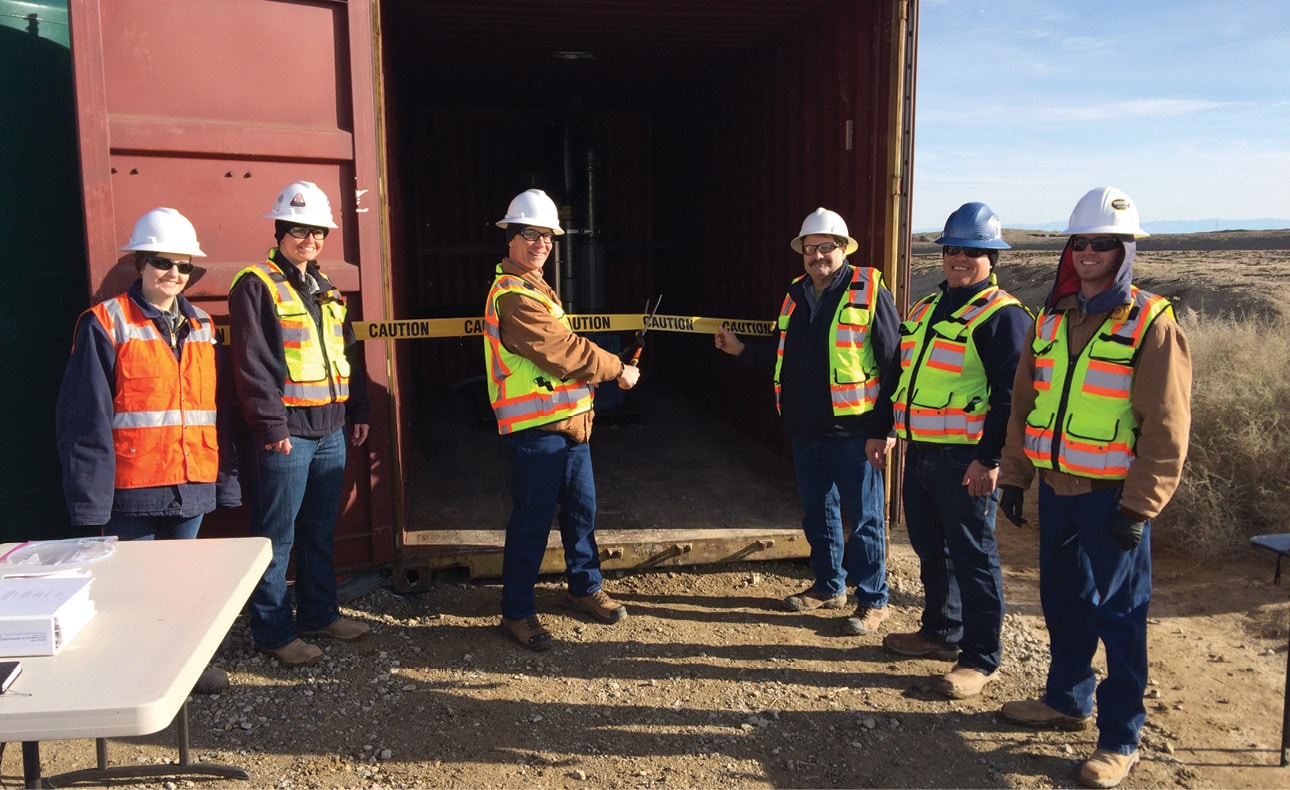
Ahtna Facility Services Inc. (AFSI) recently installed and activated an alternative remediation technology, soil vapor extraction (SVE,) at one of the areas of concern at the Department of Energy (DOE) project site in Bakersfield, California. “SVE technology is able to be used at sites where the primary chemicals of concern are Volatile Organic Compounds (VOCs) and also where there is deep contamination,” explained AFSI Civil Engineer, Jackie O’Connell, P.E., PMP. AFSI’s SVE remediation site project had a combination of deep VOCs (30 feet below ground surface) along with the contamination being on a side of a slope that made other classic excavation-type remediation techniques costly and challenging. The remediation objective for the site is to remove VOCs that are present in soil above the California Department of Toxic Substances Control’s Risk Based Screening Levels in addition to finding a solution to get rid of the associated soil vapors because they are toxic. Since VOCs can have harmful effects, it is important to find a solution to protect human health and the environment.
You may be wondering, “How exactly does SVE work?”
AFSI first conducted a pilot study to see if SVE would work. The SVE pilot study was successfully completed in August 2017 and the data collected showed that as time passed soil vapors decreased thus demonstrating that SVE would work as a remediation technique.
Implementation of a full scale SVE system involves drilling one or more extraction wells into the contaminated soil deeper than three feet below ground surface. Attached to the wells, is a large pump which creates a vacuum. Vapor phase equilibrium causes the volatile components to migrate from the soil into the vapor phase – it is easier to vacuum a gas than a liquid or solid. The vacuum pump pulls both air and chemical vapors through the soil and up the well to the ground surface for treatment. Extracted air and contaminant vapors, called “off-gasses”, are captured to prevent harmful levels of contaminants. The off-gasses are first piped from the extraction wells to an air-water separator to remove moisture, so it does not interfere with the treatment. Next, the vapors are separated from the air by pumping them through containers of activated carbon. The chemical contaminants are captured by the activated carbon while clean air exits to the atmosphere. (See A Citizen’s Guide to Activated Carbon Treatment [EPA 542-12-001.]). Abel Solis, AFSI Civil Engineer, explained, “This project now has seven extraction wells, and five monitoring wells, in addition to the eight existing study wells. Our calculations indicate that the SVE system will be operating for 1.2 years. Additionally, a subcontractor picks up saturated activated carbon filters and they are regenerated to be reused.” The use of SVE minimizes risk to site workers and the community. Reggie Laws, AFSI Site Safety Manager said, “The SVE system is easily installed and monitored, allowing the SVE treatment upkeep to be relatively short. This process mitigates the potential for possible VOC exposure to Ahtna employees and our subcontractors.”
Common factors that determine the rate of completion of the SVE are: How high contaminant concentrations are, if the contaminated area is large or deep, and if the soil is dense or moist – which slows the movement of vapors. When asked what challenges AFSI had faced in this project, AFSI Engineer Jackie O’Connell, P.E., PMP, said, “It was a challenge to coordinate with multiple subcontractors and vendors for this project. The system delivery, installation, construction, and connections needed to be performed in a particular order. [Secondly, making sure that] the system completion and startup met the schedule.” Nathan Unangst (P.G.), AFSI Staff Geologist explained how soil at the NPR-1 AOC site is perfect for SVE remediation. Nathan stated, “For SVE to be effective, there has to be a fair amount of pore space in the soil so that soil vapor can be pulled from a greater distance and consequently trapped by SVE system.” Luckily, the soil at the NPR-1 project site has ideal conditions for SVE.
To recap, approximately 15,000 cubic yards of soil with chemicals of concern (COCs) greater than the cleanup goals would be treated in situ. No digging or hauling these 15,000 cubic yards or 22,500 tons of contaminated soil. Just letting the SVE system run and monitoring the system data is how AFSI is efficiently and cost effectively remediating soil at this site. After completion of the SVE operation, the site will be restored and returned to the landowners. Upon demonstration of the success of SVE for soil remediation, DOE is hoping that SVE can be used at other AOCs with similar conditions.
